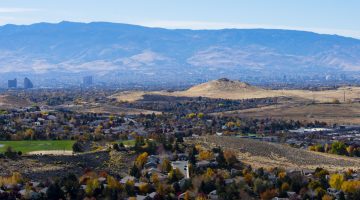In a chaotic year featuring heated elections and social unrest, the most recent and strangest phenomenon of 2016 so far is the nationwide creepy clown sightings. What appeared to be an isolated incident in August with a boy in Greenville, South Carolina, has swept the country and even extended its reaches overseas. The clown outbreak has reached the University of Nevada, Reno, and the community in two different incidents.
Although few arrests or incidents have occurred, it is clear that people are on edge about a possible clown epidemic.
While it is unclear how the clown scares began, one possible spread of fear could be blamed on social media. Since the first incident, several clown sighting pages have appeared and allow people to post videos or sightings, confirmed or not.
Earlier this month, Sparks police responded to an apparent clown sighting near Reed High School, but when they arrived there was no clown in sight. Witnesses had reported seeing a clown holding a machete near the high school.
An alleged clown sighting was reported on campus in the William J. Raggio building this October. The sighting is unconfirmed and is believed to have been a prank. Nonetheless, many students are worried about this spread of clowns, including Asiarae Booth, a business major at UNR.
“I do believe there is a big clown problem,” Booth said. “I am more nervous walking home, especially at night. I am also worried about Halloween. I think I probably won’t go out this year because of the possibility of clowns.”
Several other students disagree that the clown sightings are dangerous and believe they are nothing more than pranks. Ian Mastick, a civil engineering major, and Henning Kelly, an international affairs major, believe the clown sightings are pranks promulgated by social media.
“It seems to be a case of mass hysteria, and people are just getting involved to be part of a current fad,” Mastick said.
These clown sightings have not only affected schools and neighborhoods but the professional clown community. Some in the professional clown community have concerns that the creepy clown publicity could negatively affect their business.
Earlier this month in Tucson, Arizona, the community prepared for a “Clowns Lives Matter” march to reassure people that not all clowns are scary or violent. The march was canceled after death threats and harassment were directed at the organizer of the event, Shelly Guitierrez, through social media. Gutierrez told Arizona’s ABC 15 that they would plan another “Clowns Lives Matter” event after things “settle down a bit.”
In Mississippi, Kemper County has taken a direct approach to the clown situation. They have implemented a local law that states, until Nov. 1, all clown makeup, clothes and masks are banned. Violating the law could lead to a fine of $150. The county claims the purpose of this law is to ensure the safety of everyone in the community during the Halloween season.
The Halloween season is a time for fun and festivities, but it is important to stay safe.
“It is not illegal to be in costume, but putting on a costume and then going up and trying to scare people in this day and age wouldn’t be the best suggested outlet of your energy,” said Ray Price, Washoe County School District Deputy Chief.
Rachel Spacek can be reached at rspacek@sagebrush.unr.edu and on Twitter @TheSagebrush











